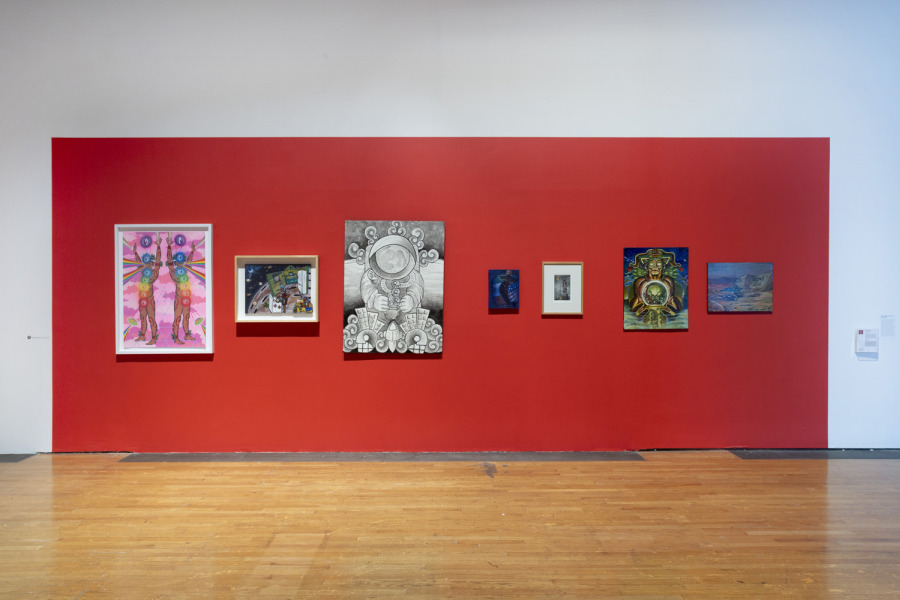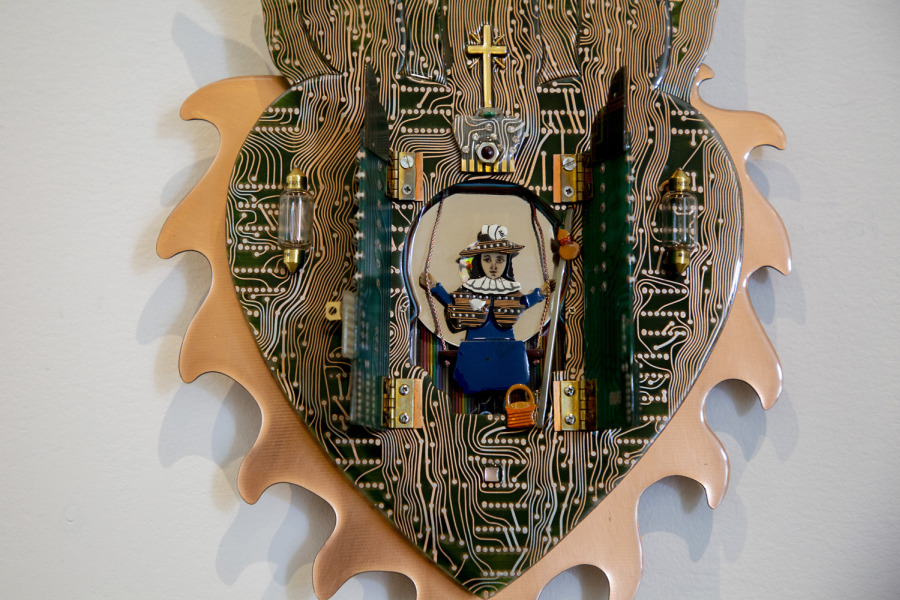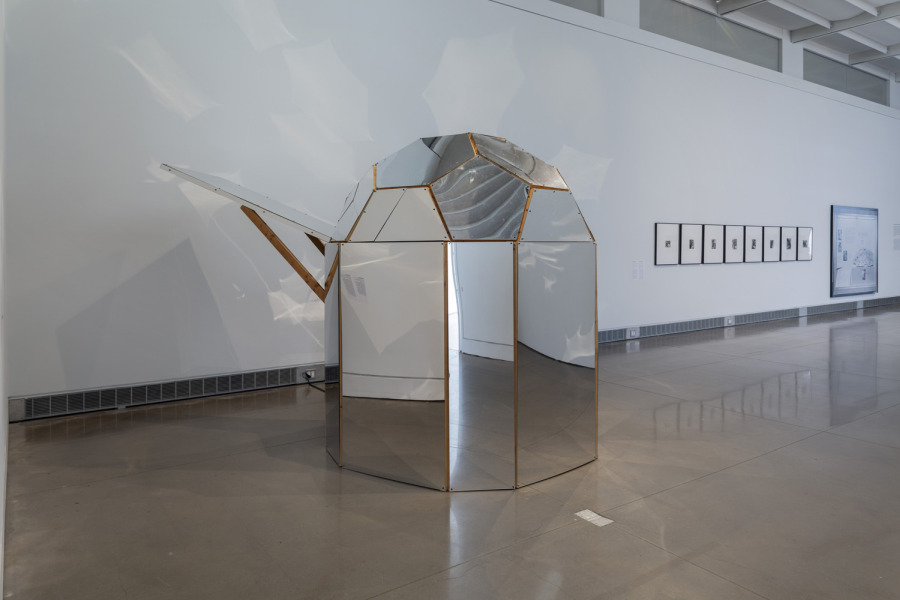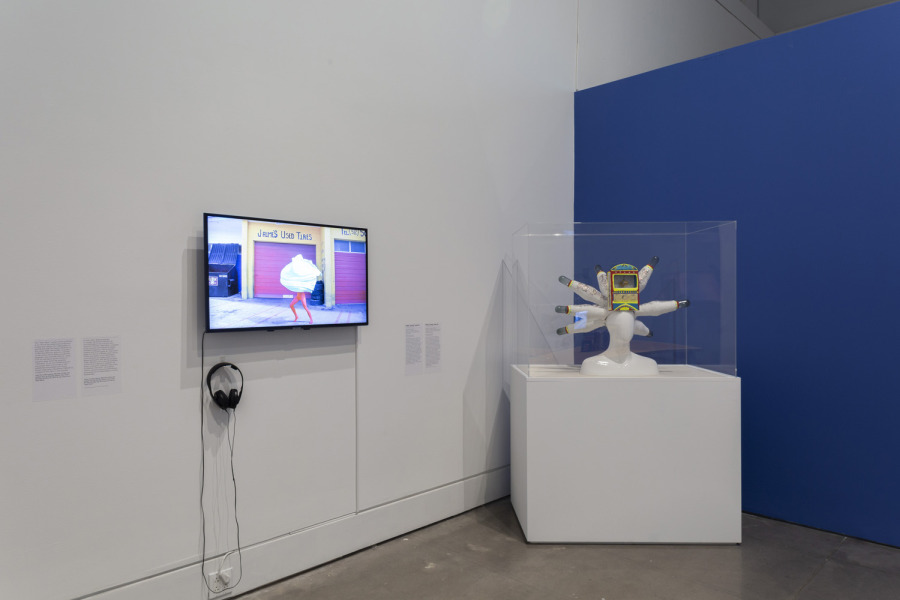
Mundos Alternos:art And Science Fiction in The Americas
Mundos Alternos: Art and Science Fiction in the Americas brings together the work of 30 international artists from across Latin America and the Caribbean, including Mexico, Cuba, Argentina, El Salvador, Brazil, Chile and Puerto Rico, with Latino/a artists from throughout the United States who have tapped into science fiction’s capacity to address cross-cultural dynamics and imagine new realities.
Offering both utopian and dystopian visions, the over 50 projects on view speculate on the past and future. They address contemporary issues of nationhood, citizenship, and borders, and question the capacity of advanced technology to create radical change in the social order. New technologies, communities, creatures, and world orders come together in the fictive future worlds of science fiction, in which they could exist.
Previously presented at UCR ARTS at the University of California, Riverside, the exhibition’s travel to the Queens Museum continues a transnational conversation about speculative aesthetics at a time when immigrant futures are facing uncertainty. As a former site of two New York World’s Fairs that brought technologically-driven, futuristic ideas to a world stage, the Museum is the most relevant venue to host a show of this kind. Located in the borough of Queens, a region transformed by waves of Caribbean, South American, and Mexican migration, Mundos Alternos and its public programs address contemporary issues of nationhood, citizenship, and borders, and invite East Coast audiences to imagine an alternate world where many worlds may cohabitate.
The first exhibition of its kind, Mundos Alternos presents a distinctly Latin American science fiction, extending the growing study of the genre from literature and film to the visual arts. Organized in thematic constellations, the works illuminate a transnational and transcultural “Latinidad.” New and old technologies, communities, creatures, and world orders come together in this fictive space, engaging with an understanding of shared hemispheric exchanges and experiences in language, culture, and visual expression. Taken together, they investigate science fiction’s power to create alternative possibilities that counter the colonial enterprise which has shaped our world.
ALTERNATE AMERICAS
In addition to leading us to explore ideas about the future, science fiction can help us create alternate narratives for the past. The artists presented here recognize that history often favors those in power and omits the perspectives of marginalized groups or individuals. Through their work they create opportunities for us to reimagine places and events that have been cemented into our experience. While they lead us to ask, “What if things had unfolded differently?” they also make us question the reliability of historical records altogether. How do we evaluate historical facts if they were recorded in biased or potentially incomplete ways?
Adál (1949) exhibits Coconauts in Space (1994-2016), prints on metal that present a reimagined account of the first moon landing, in which Puerto Rican astronauts, the “Coconauts,” landed on the moon in 1963. The artist uses this claim of ownership as a metaphor for the U.S.’s colonial expansion into Puerto Rico, where he is from. Site-specific wall drawings by Glexis Novoa (Cuba, 1964) are dispersed throughout the Museum and consider the relationships between architecture and political power. This fantastical and futuristic cityscape is inspired by the architecture of the Queens Museum itself, and other pavilions populated as a part of the 1939-40 and 1964-65 World’s Fairs, and the Museum’s own Panorama of the City of New York, a 9,000 square foot model of the City dating from 1964.
INDIGENOUS FUTURISMS
Throughout history, Indigenous knowledge has often been cast as archaic and unsophisticated from the point of view of Western colonizers. These works explore the relationship between Indigenous communities and technology, highlighting links between ancient ideas, tools, and beliefs, and present-day realities. In doing so, the artists focus on a revaluation of ancient wisdom and sovereignty, and demonstrate that inherited knowledge is integral to the gradual evolutions in language, social relations, spirituality, and creativity that have created the world we live in.
Highlights in this section include Rigo 23’s Autonomous InterGalactic Space Program (2009-ongoing), created in collaboration with indigenous Zapatista artists and artisans from Chiapas, Mexico. In workshops, Rigo 23 (Portugal, 1966) asked Zapatistas to imagine a future with complete autonomy from the Mexican government and global forces. This artwork emerged from these sessions as a technoculture, futuristic environment filled with Zapatista and Mayan cosmic references. Elsewhere, Guillermo Bert (Chile, 1959) presents his Encoded Textiles (2011-2012), each one paired with a documentary video on a member of the Mapuche tribe, the largest indigenous population in Chile, and the only group not conquered by Spanish colonists in the sixteenth century.
TIME TRAVEL
Time travel narratives are about changing history, purposefully or accidentally. If we alter the past, how will it change the present? And if we alter the future, how will history be affected? In the installations on view here, we see that manipulations of progressive time, memory, or translation can alter what we know about imperialism, industry, and knowledge itself—a reminder of how the past and future are part of a cosmic continuum always alive in our present time.
Here, Clarissa Tossin (Brazil, 1973) exhibits a new sculptural work, Future Fossil (2018), which explores the post-apocalyptic conditions of the Earth’s ecological collapse. A ruin of a world yet to come, she molded her own plastic waste to speak to the enduring footprint left by humans on Earth, contrasting them with materials related to Amazonian indigenous aesthetic traditions which harmonize with the environment.
In The Cosmos (Spaceship) [2015], Beatriz Cortez (El Salvador, 1970) takes inspiration from the World’s Fairs of the late 19th and early 20th centuries, in which futuristic visions of Modernity and Western imperial exploits were often manifest in the aesthetics of pavilion architecture. Cortez complicates the dominant narratives presented at these events, turning her “pavilion” into a decolonial time-capsule with a 1911 audio recording of Ishi, an indigenous Yahi man who survived the California genocide.
CORNERSTONES
Cornerstones presents foundational works of Latinx science fiction in film and literature. Highlights include The Eaton Collection of Science Fiction & Fantasy at the University of California, Riverside, one of the biggest and most comprehensive collections of science fiction, fantasy, horror, and utopian literature, ephemera, and film. This selection of ten books contains some of the Eaton’s most popular works produced by Latin American authors.
REIMAGINING THE AMERICAS
Artists in this section employ wide-ranging references from space travel, technoculture, spiritual traditions, and mythology in order to tap into science fiction’s ability to counter limits. Through the lens of the supernatural they present works that illuminate and re-envision terrestrial realities that have resulted from colonial history, immigration control, and the spread of American consumerist culture—all of which have shaped social and political relationships between the U.S., its territories, and Central and South America.
Featured in the center of the Museum is Organic Arches (Time Traveler) [2014-2017] by Chico MacMutrie and Amorphic Robot Works (ARW) (USA, 1961). Interested in robotics, the bodily form, and movement, Chico MacMurtrie and his Brooklyn-based collective ARW constructed this large, soft, kinetic sculpture from high-tensile, Tedlar fabric tubes, and pressurized air. Giving the appearance of life, when it is turned on its arm-like tendrils continuously fill up and reach out. As they deflate and curl up, the collapsed arches retreat into the abstract sign language of a computer-controlled organism. Defying expectations of a fixed object or form, the work becomes a vessel for considering travel—across time, borders, and physical states.
ALIEN SKINS
The works displayed in this section include costumes from performances and everyday life that reorient Latino/a existence across global and planetary confines. From cosmic characters who transcend time and space in their own barrios and over national borders, to explorations of identity through politically motivated, cross-species, and gender-nonconforming personas, artists reveal the ways in which we can unfasten identity from its earthly boundaries and stratifying social constructions.
The exhibition at the Queens Museum features an introduction to the section Alien Skins, which can be viewed completely at the Leslie Lohman Museum of Lesbian and Gay Art in Manhattan (April 25–May 26, 2019). Included are queer feminist artist Carmelita Tropicana’s costumes that she donned for film-performance-lectures that she made with her sister, filmmaker Ela Troyano; photographs by Ricardo Valverde (USA, 1946-1998); and Hector Hernandez (USA, 1974) Bulca (2015), and Sound of Winter (2014), photographs that feature otherworldly figures that he calls “hyperbeasts,” colorful blobs of swirling fabric with legs.
Also on view at The New York Hall of Science (April 7 – August 18, 2019) is artist Rubén Ortiz Torres’ (Mexico, 1964) Alien Toy (La Ranfla Cósmica) [1997]. The video features a kinetic sculpture inspired by the customized aesthetics of Chicano Lowriders. Alien Toy is a lo-fi pastiche of popular science fiction imagery, like Star Wars and UFO sightings, as they come together with a white Nissan pickup truck, a model commonly used by U.S. Border Patrol.
The public programs will center on contributions from artists, writers, poets, scholars, and musicians that engage “futurisms” from a wide range of perspectives. Topics cover geopolitical, social, environmental, and personal themes, and will include screenings of works by Alex Rivera (USA, 1973) and Coco Fusco (USA/Cuba, 1960); performances by Guillermo Gómez-Peña (Chile, 1959), Guadalupe Maravilla (El Salvador, 1976), and Carmelita Tropicana (Cuba, 1951); readings with writers such as N.K. Jemisin; as well as talks and panels with scholars including Catherine Sue Ramírez.
Mundos Alternos is curated by Robb Hernández, Assistant Professor of English at UCR; Tyler Stallings, Director of the Frank M. Doyle Arts Pavilion at Orange Coast College, and former Artistic Director of the Barbara and Art Culver Center of the Arts at UCR ARTS; and Joanna Szupinska-Myers, Senior Curator at the California Museum of Photography at UCR ARTS. The traveling iteration is organized by Hitomi Iwasaki, Director of Exhibitions and Curator at the Queens Museum, and Joanna Szupinska-Myers.
MUNDOS ALTERNOS: ART AND SCIENCE FICTION IN THE AMERICAS
Artists: ADÁL, AZTLÁN Dance Company, Guillermo Bert, Erica Bohm, Tania Candiani, Beatriz Cortez, Claudio Dicochea, Faivovich & Goldberg, Sofía Gallisá Muriente, Guillermo Gómez-Peña, Hector Hernandez, Gyula Kosice, La Gravedad de los Asuntos (Nahum and Ale de la Puente with Tania Candiani and Juan José Díaz Infante), L.A. VATOCOSMICO c-s, Robert “Cyclona” Legorreta, Chico MacMurtrie / Amorphic Robot Works, Guadalupe Maravilla, Marion Martinez, MASA—MeChicano Alliance of Space Artists (Luis Valderas and Paul Karam with selected participants Sergio Hernández, Debora Kuetzpal Vasquez, Miguel Luciano, Laura Molina, Tony Ortega, and Raúl Servín), Jillian Mayer, Mundo Meza, Glexis Novoa, Rubén Ortiz Torres, Rigo 23, Alex Rivera, Clarissa Tossin, Carmelita Tropicana, Luis Valderas, Ricardo Valverde, José Luis Vargas.
Queens Museum, New York City Building, Flushing Meadows Corona Park, Queens, New York
Satellite venues in NYC: The Leslie-Lohman Museum of Gay and Lesbian Art, Museum of the Moving Image, Sugar Hill Children’s Museum of Art & Storytelling, and the New York Hall of Science
April 7 – August 18, 2019
Featured image: Laura Molina, Amor Alien, 2004, oil paint, fluorescent enamel, metallic powder, 35 x 47 in. Courtesy of the National Museum of Mexican Art, Chicago.
También te puede interesar
ICP PRESENTS FIRST NYC CAREER SURVEY OF MURIEL HASBUN
“Tracing Terruño” is the first comprehensive career survey in New York City of multidisciplinary artist, educator, and advocate for Central American culture and history, Muriel Hasbun (b. 1961), curated by Elisabeth Sherman, Senior Curator...
BORN IN FLAMES: FEMINIST FUTURES
“Born in Flames” highlights a number of artists referencing non-Western folklore and mythologies to create alternate futures. Their works are representative of how each artist is thinking about futurism––including Afro-, Asian-, Indigenous-, and Latinx-futurism,...
OPERATIONAL EXCELLENCE
In a moment when cryptocurrency has swiftly become a global phenomenon, this exhibition considers the ways in which dematerialized currency and the ostensible abstraction of value still have tangible impacts. Requiring access to the...















